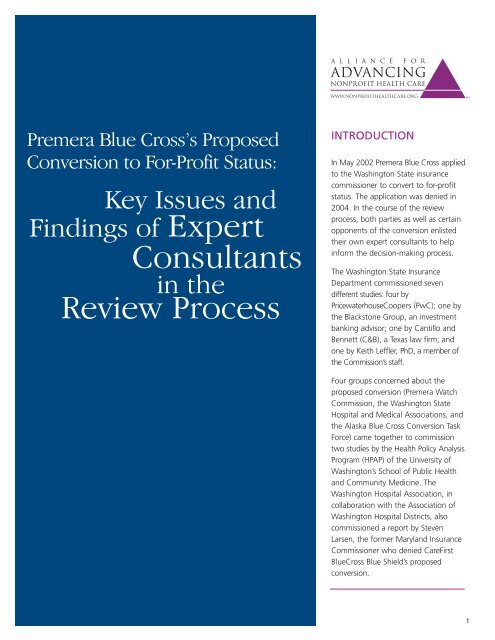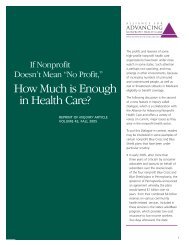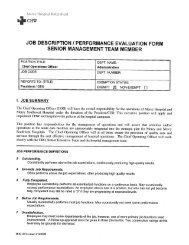Premera Blue Cross's Proposed Conversion to For-Profit Status
Premera Blue Cross's Proposed Conversion to For-Profit Status
Premera Blue Cross's Proposed Conversion to For-Profit Status
- No tags were found...
You also want an ePaper? Increase the reach of your titles
YUMPU automatically turns print PDFs into web optimized ePapers that Google loves.
<strong>Premera</strong> <strong>Blue</strong> Cross’s <strong>Proposed</strong><strong>Conversion</strong> <strong>to</strong> <strong>For</strong>-<strong>Profit</strong> <strong>Status</strong>:Key Issues andFindings of ExpertConsultantsin theReview ProcessINTRODUCTIONIn May 2002 <strong>Premera</strong> <strong>Blue</strong> Cross applied<strong>to</strong> the Washing<strong>to</strong>n State insurancecommissioner <strong>to</strong> convert <strong>to</strong> for-profitstatus. The application was denied in2004. In the course of the reviewprocess, both parties as well as certainopponents of the conversion enlistedtheir own expert consultants <strong>to</strong> helpinform the decision-making process.The Washing<strong>to</strong>n State InsuranceDepartment commissioned sevendifferent studies: four byPricewaterhouseCoopers (PwC); one bythe Blacks<strong>to</strong>ne Group, an investmentbanking advisor; one by Cantillo andBennett (C&B), a Texas law firm; andone by Keith Leffler, PhD, a member ofthe Commission’s staff.Four groups concerned about theproposed conversion (<strong>Premera</strong> WatchCommission, the Washing<strong>to</strong>n StateHospital and Medical Associations, andthe Alaska <strong>Blue</strong> Cross <strong>Conversion</strong> Task<strong>For</strong>ce) came <strong>to</strong>gether <strong>to</strong> commissiontwo studies by the Health Policy AnalysisProgram (HPAP) of the University ofWashing<strong>to</strong>n’s School of Public Healthand Community Medicine. TheWashing<strong>to</strong>n Hospital Association, incollaboration with the Association ofWashing<strong>to</strong>n Hospital Districts, alsocommissioned a report by StevenLarsen, the former Maryland InsuranceCommissioner who denied CareFirst<strong>Blue</strong>Cross <strong>Blue</strong> Shield’s proposedconversion.1
<strong>Premera</strong> commissioned seven of its own studies, generally <strong>to</strong>counter the findings in the reports commissioned by theInsurance Department and by the above groups concernedabout the conversion. <strong>Premera</strong>’s consultants included: E. LewisReid, former President and CEO and current Board member ofthe California Endowment, the largest private foundationcreated by a <strong>Blue</strong>s conversion; Bank of America Securities LLC(BAS), the investment banking arm of Bank of America withexperience with BCBS companies; NovaRest Consulting, anIllinois consulting firm specializing in financial and actuarialanalyses; Milliman USA, a Seattle actuarial consulting firm;National Economic Research Associates, Inc. (NERA); TowersPerrin, a human resources and executive compensationconsulting firm; and John Steel, a Seattle lawyer specializingin corporate and securities law with experience inacquisitions/mergers and initial public offerings.PURPOSE OF THIS REPORTThis report presents a summary of the findings andconclusions of the major consultant reports commissioned inthe course of these deliberations. These studies arenoteworthy not only because they undoubtedly had a majorbearing on the commissioner’s decision, but also because theyprovide a fascinating and informative illustration of the rangeand complexity of the major issues—philosophical, strategic,and technical—that merit attention in analyzing and reachingdecisions on any proposed conversions.THE ISSUESAll of the reports by the consultants commissioned by theInsurance Department, as well as those commissioned by theexternal groups noted above, expressed strong concernsabout some or many major elements or potential impacts ofsuch a conversion. These potential impacts and elements canbe categorized as follows:• Need for capital• Need <strong>to</strong> attract or retain management talent• Fundamental nonprofit versus for-profit orientation andcommunity benefits• Medical loss and administrative cost ratios• Access <strong>to</strong> insurance (premium rates, underwritingpractices, types of benefit products and geography)• Provider rates and relationships• Quality and cus<strong>to</strong>mer service• Local versus national ownership• Fair market value and the proposed nonprofitconversion foundationA summary of the consultant reports is presented belowunder these categories.SPECIAL NOTEThe study prepared by the Health Policy Analysis Program(HPAP) merits some explanation, as it appears <strong>to</strong> contain oneof the most extensive, if not the most extensive, reviews ofthe research surrounding previous <strong>Blue</strong>s conversions (actualand proposed), focusing on 10 of those cases. HPAPsupplemented this literature review with interviews of consumerand provider leaders in six of those cases, four national experts,experts on local and state insurance markets in Washing<strong>to</strong>nState and Alaska, and many providers in both states. HPAPchose the 10 cases (CA, CO, GA, KA, ME, MD, MO, NH, NC,and VA) based on their relative currency and the availability ofrelatively good information. HPAP notes that there wereparticularly significant policy analyses in the Kansas, NorthCarolina, and Maryland proposals, and that the NorthCarolina case also included extensive interviews with expertsin the California, Georgia, Missouri, and Virginia cases.HPAP found one or more of the following reasons given <strong>to</strong>justify the conversion in these 10 cases: access <strong>to</strong> capital,economies of scale, broader markets <strong>to</strong> serve multi-stateemployers, diversification of risk, and retention of talentedmanagement. Some observers in some of these cases werereported <strong>to</strong> believe that an unstated reason for the conversionwas <strong>to</strong> enrich the senior executives through s<strong>to</strong>ck, severancearrangements and/or other financial incentives.HPAP notes a complicating fac<strong>to</strong>r in analyzing many of theproposed or actual conversions that could lessen the observed2
or projected impacts of a conversion. HPAP reported thatmany of these cases (e.g., NC, GA, MO, VA) involved changesin behavior by the plans well before they announced theirintent <strong>to</strong> convert. National experts that HPAP interviewedattributed this <strong>to</strong> a planned strategy <strong>to</strong> put the plans in thestrongest possible financial position <strong>to</strong> enhance the value ofs<strong>to</strong>ck at the time of conversion. A second complicating fac<strong>to</strong>rnoted in these analyses was that many of these conversionswere followed in a few years by sales <strong>to</strong> Anthem or Wellpoint,making it difficult <strong>to</strong> separate the impacts of conversion fromnonprofit <strong>to</strong> for-profit versus change from local <strong>to</strong> nationalownership. HPAP felt it was important <strong>to</strong> take in<strong>to</strong> accountboth of these complicating fac<strong>to</strong>rs in its analyses, because theprevious cases suggested a high probability that <strong>Premera</strong>would be acquired by a national for-profit company if it were<strong>to</strong> convert <strong>to</strong> for-profit status.FINDINGS OF CONSULTANTSON THE ISSUESNeed for Capital:Various consultants engaged by the Insurance Commission orthe concerned coalitions reported that <strong>Premera</strong> had not madea convincing case <strong>to</strong> convert in order <strong>to</strong> secure more capital:• Steven Larson stated that the business case made by <strong>Premera</strong>was not compelling and had few specifics, and thereforecould not be considered a mitigating fac<strong>to</strong>r <strong>to</strong> offset likelynegative impacts of the conversion.• PricewaterhouseCoopers (PwC) noted that added capitalmight be used in large part <strong>to</strong> allow <strong>Premera</strong> <strong>to</strong> growoutside the two states, not benefiting their residents.• The Blacks<strong>to</strong>ne Group (BG), while acknowledging somebenefits associated with strengthening reserves and havinggreater access <strong>to</strong> capital and increased financial flexibility,also felt that <strong>Premera</strong> had not demonstrated a clear need inthe near-<strong>to</strong>-medium term for the amount of capitalcontemplated ($100–150 million). BG found that cash flowfrom operations was sufficient <strong>to</strong> meet <strong>Premera</strong>’s shorttermand medium-term needs. BG also stated that someadded capital was possible through increased debtfinancing and sale/lease-back of assets.• The Health Policy Analysis Program (HPAP) stated that thoseproposing <strong>to</strong> convert typically argue that new capital willallow them <strong>to</strong> grow in size and realize economies of scale,but that size does not necessarily lead <strong>to</strong> lower administrativecosts. Integration of claims and other data systems iscomplex and costly, and profit levels in health insurancecompanies are highly related <strong>to</strong> local market knowledge.In contrast, <strong>Premera</strong>’s consultants posited as follows:• Bank of America Securities (BAS) stipulated that all healthinsurance companies undergoing IPOs over the past 13years that raised capital did not have a specific statedpurpose for most of the added capital other than forstrategic flexibility.• NovaRest Consulting argued that <strong>Premera</strong>’s risk-basedcapital (RBC) ratio of 406% was only slightly better than<strong>Blue</strong> Cross <strong>Blue</strong> Shield Association’s required minimum of375% <strong>to</strong> avoid moni<strong>to</strong>ring, and that an RBC of 500% ormore was a good rule of thumb <strong>to</strong> address fluctuations inearnings, capital projects, and future growth. Of theoptions available for increasing capital (increasing profits,selling assets, borrowing, conducting acquisitions/mergers,or selling s<strong>to</strong>ck), NovaRest stated that raising capitalthrough the equity market was superior because it did nothave <strong>to</strong> be repaid. It acknowledged, however, thatincreased earnings would be necessary <strong>to</strong> pay dividends orincrease the value of the s<strong>to</strong>ck <strong>to</strong>satisfy inves<strong>to</strong>rs.Need <strong>to</strong> Attract or Retain Management Talent:Two of the consultants engaged by the Insurance Commissionreported that <strong>Premera</strong> had not demonstrated that the conversionwas needed <strong>to</strong> attract or retain management talent:• Cantillo and Bennett (C&B) found a very favorable (low)management turnover ratio, which they felt “raisedthe specter of a conflict of interest.”• PwC found that <strong>Premera</strong>’s turnover rates were significantlylower than industry standards, with its executivecompensation practices already above market, in terms ofbase salary, <strong>to</strong>tal cash (base salary plus bonus) and <strong>to</strong>taldirect compensation (<strong>to</strong>tal cash compensation plus longtermincentives). PwC also noted that <strong>Premera</strong> had notprovided, as of this reporting, sufficient information onwhat the CEO and other executives could “walk away3
with” as a result of the conversion (e.g., provisions for s<strong>to</strong>ckor s<strong>to</strong>ck options, expected changes in annual and long-termincentive plans or in retirement plans).Towers Perrin (TP), <strong>Premera</strong>’s consultant, countered that the<strong>to</strong>tal direct compensation for executives was at or below themarket median in aggregate and individually in all but a fewcases. TP also disagreed that the executive severanceprotection was above market and that post-conversioncommitments were unreasonable or <strong>to</strong>o generous compared<strong>to</strong> those in other IPO transactions. In presenting therationale for its positions, TP criticized PwC’s analytictechniques (i.e., using only <strong>Blue</strong>s plans as the comparisongroup and not fac<strong>to</strong>ring in <strong>Premera</strong>’s lack of a COOposition, the duties of which were shared among several<strong>Premera</strong> executives).Fundamental Nonprofit Versus <strong>For</strong>-<strong>Profit</strong> Orientation:The consultants engaged by the coalitions concerned with theconversion felt strongly that a change from nonprofit <strong>to</strong> for-profi<strong>to</strong>wnership would fundamentally change the inherent valuesand motivations, and consequent behaviors, of the organization,with potentially significant adverse impacts (including reducedcommunity benefits) on providers, policyholders and the public.• Steven Larsen contended that, while there are certainsimilarities in how both types of organizations operate,including when necessary withdrawing from lines ofbusiness and raising rates, nonprofits take these actions in abroader context and with the ultimate objective of servingthe nonprofit mission, not maximizing value for outsideinves<strong>to</strong>rs or owners. He stated that this distinction inmission provides the nonprofit with greater flexibility <strong>to</strong> actin a way that lessens or ameliorates potential negativeimpacts on its stakeholders.• HPAP, noting that the community benefits provided byhealth plans are often informal and difficult <strong>to</strong> measure,nonetheless found that “available information suggests thatnonprofit health plans are more likely than for-profits <strong>to</strong>provide benefits <strong>to</strong> the community, including safety netservices, targeting programs <strong>to</strong> low-income neighborhoods,and providing more charitable contributions”. While havingno access <strong>to</strong> information about <strong>Premera</strong>’s current level ofcommunity benefits, HPAP cited examples of views similar <strong>to</strong>Steven Larsen’s from its own interviews and thoseconducted by other consultants in the 10 cases:o “When we were dealing with BCBS (of Maine), the plansupported things like community rating, but now it is aconstant fight. When you keep a plan nonprofit, you’rekeeping the values viable.”o “<strong>For</strong> 9 out of 10 decisions…they’ll (nonprofits and forprofits)decide the same thing, but the issue is what is theimpact of the 1-in-10 decision where they will differ?”o Some experts interviewed about the North Carolina casesaid that it is “easier <strong>to</strong> regulate nonprofits and <strong>to</strong> getthem <strong>to</strong> work for the public good since you can ask moreof them regarding pricing and access for vulnerablepopulation groups”.One of <strong>Premera</strong>’s consultants, National Economic ResearchAssociates (NERA), stated that <strong>Premera</strong> would not behaveany differently following conversion regarding pricing,product design, lines of business or geography becauseit is competition, not ownership status, that shapes andconstrains a health insurer’s actions.Medical Loss and Administrative Cost Ratios:• Supplementing its findings on the more intangible, inherentvalues of nonprofit ownership, HPAP stated, based onempirical comparisons of nonprofit <strong>Blue</strong>s with for-profit<strong>Blue</strong>s and commercial insurers, that “a converted <strong>Premera</strong>will likely reduce its medical loss ratio…and increase itsadministrative cost ratio in order <strong>to</strong> attain and maintainadequate profit margins”. HPAP projected that as much as10% of <strong>Premera</strong>’s revenues ($200 million annually) wouldbe shifted from payment for actual health care <strong>to</strong> otherpurposes. HPAP noted that for-profit health insurers typicallyseek underwriting gains of 2–3 percent. Those gains mustcome from lower medical payments or lower administrativecosts, yet for-profit insurers typically have higheradministrative costs. With average medical loss ratios of74% and 80% respectively for for-profit <strong>Blue</strong>s and for-profitcommercial insurers, compared <strong>to</strong> 84% for nonprofit <strong>Blue</strong>s(<strong>Premera</strong>’s was 85% in 2002), HPAP stated that unless thefor-profits were managing care much better <strong>to</strong> account fortheir higher administrative costs, of which there was noevidence, then their higher administrative costs were “likely<strong>to</strong> include profits and their distribution <strong>to</strong> shareholders”.4
Access <strong>to</strong> Insurance:The following consultants engaged by the InsuranceCommission and the coalitions expressed concerns aboutreductions in access <strong>to</strong> insurance:• PwC stated that as a public company <strong>Premera</strong> “would beexpected <strong>to</strong> reach target operating margins over time foreach line of business, whereas currently some appear <strong>to</strong>be subsidized.”• HPAP found a “mixed picture” of the effects of conversionon insurance access, noting that in four cases the converted<strong>Blue</strong>s plans continued <strong>to</strong> cover their entire geographic regionsand individual as well as group markets. HPAP also foundno evidence that the converted plans had exited publicprogram business <strong>to</strong> any greater degree than the nonprofitplans. Ultimately, however, HPAP concluded that the overallweight of the empirical evidence across the 10 cases fell onthe side of negative impacts on insurance access. Accordingly,it expressed the same concern as PwC, as well as noted theincreased likelihood that a converted <strong>Premera</strong> would becomemore aggressive in benefit design and underwriting practices,especially impacting the individually insured and peoplewith greater medical needs. Also, while noting thatempirical research from publicly available information hadnot been conducted <strong>to</strong> verify predictions of premiumincreases, HPAP also cautioned that <strong>Premera</strong> mightselectively employ this practice.• Steven Larsen contended that <strong>Premera</strong>’s dominance in theindividual market in certain areas gave it market powerover both purchasers of health insurance and providers inthose areas, and that such market power would inevitablybe exploited more aggressively by a for-profit <strong>Premera</strong>.One Insurance Commission consultant, however, Keith Leffler,did not feel that <strong>Premera</strong>, even in Eastern Washing<strong>to</strong>n whereit had substantial market power, could or would use it <strong>to</strong>raise premiums more dramatically if converted.<strong>Premera</strong>’s consultants reported that there would be nonegative impacts on insurance access:• NERA stated that <strong>Premera</strong> had already been focused onthe bot<strong>to</strong>m line and offered only products makingcommercial sense because of competitive and legalconstraints, such that nothing different would occur in itspractices following conversion.• Milliman USA projected no increases, and perhaps aslight decrease, in <strong>Premera</strong>’s premium rates as a resul<strong>to</strong>f conversion.Provider Rates and Relationships:The findings and conclusions of the consultants engagedby the Insurance Commissioner and concerned coalitiongroups included some selective concerns about provider ratesand relations:• HPAP stated that while there was information from the 10case studies that conversions could increase tensions inrelations with providers, other fac<strong>to</strong>rs, such as the <strong>Blue</strong>s’his<strong>to</strong>rical dependency on broad provider networks, couldmitigate against a converted plan taking a more aggressivenegotiating stance. In addition <strong>to</strong> business strategy, HPAPfound that market share, more than the corporate form ofthe owner, might well be the primary fac<strong>to</strong>r impactingrelations, noting <strong>Premera</strong>’s significant market power inEastern Washing<strong>to</strong>n and in Alaska.• PwC noted <strong>Premera</strong>’s dominance in Eastern Washing<strong>to</strong>n andthe potential negative consequences for providers of aconverted <strong>Premera</strong> facing increased earnings pressures.• Keith Lefffler, noting an 80% market share in 8 countiesof Eastern Washing<strong>to</strong>n, and 70% overall in that region ofthe state, found that <strong>Premera</strong> had already used itsnegotiating power in provider fees and “could change itspayment and contracting procedures <strong>to</strong> more fully exploit itsmarket power”.NERA, one of <strong>Premera</strong>’s consultants, argued that <strong>Premera</strong>’sstrategic need for a broad provider network, even in areaswhere it had greater market share, would preclude it fromrelating differently with its providers post-conversion. NERAstated that its data analyses showed no statistical relationshipbetween high market share and lower rates provided by<strong>Premera</strong>, with physician fees in Eastern Washing<strong>to</strong>n notsignificantly lower than in Western Washing<strong>to</strong>n. NERA alsonoted that rural hospitals in Eastern Washing<strong>to</strong>n werepermitted <strong>to</strong> negotiate collectively with <strong>Premera</strong>.5
Quality and Cus<strong>to</strong>mer Service:HPAP, commissioned by the concerned coalitions, was theonly consultant that addressed this issue:• HPAP cited several studies providing some indication thatnonprofit and local plans rated higher with cus<strong>to</strong>mers onsome quality and service indica<strong>to</strong>rs than did for-profit andnational plans. Based on those findings, HPAP extrapolatedthat a converted <strong>Premera</strong> could drop in performancerelative <strong>to</strong> patient satisfaction, cus<strong>to</strong>mer service, attention<strong>to</strong> certain preventative measures, reports of administrativebarriers, and reports of delayed care. HPAP noted that<strong>Premera</strong>’s performance on quality indica<strong>to</strong>rs from aWashing<strong>to</strong>n public program study showed it <strong>to</strong> be aboutaverage currently.• HPAP also reported, however, that some national researchsuggested that a converted <strong>Premera</strong> might focus greaterefforts on providing more information <strong>to</strong> patients regardingtheir care management and on better patient-focusedinformation systems.Local Versus National Ownership:HPAP was also the only consultant that addressed this issue.Its major findings and conclusions were as follows:• A converted <strong>Premera</strong> would likely be purchased by anational for-profit insurer. HPAP noted that 13 of 16 <strong>Blue</strong>sthat converted over the past 15 years were now owned byAnthem or Wellpoint. One national expert interviewed byHPAP felt that these national insurers had a new acquisitionstrategy, delaying involvement until a conversion <strong>to</strong> a localIPO had already occurred, in order <strong>to</strong>: avoid beingembroiled in that process; reduce the risks of disapproval;and avoid having <strong>to</strong> “ante up” for a conversion foundationthat could lower its s<strong>to</strong>ck value. HPAP cited an examplewhere the CEO of a Wisconsin <strong>Blue</strong>s plan publicly statedprior <strong>to</strong> the conversion <strong>to</strong> a local IPO that it had no plans <strong>to</strong>be purchased after the conversion. Later, however, the IPOwas purchased by Wellpoint, and the same CEO stated that“when Wellpoint approached us, we had a fiduciaryresponsibility <strong>to</strong> our shareholders <strong>to</strong> investigate the offer”.• HPAP also concluded, based on both theory and theempirical evidence it examined, that a converted <strong>Premera</strong>purchased by a national for-profit company would “focusmore on national accounts than on the uniquecircumstances of markets, consumers, and providers ofAlaska and Washing<strong>to</strong>n.” HPAP felt that loss of “localness,”including the community orientation of management, couldexacerbate the problems created by conversion:o Less willingness <strong>to</strong> continue unprofitable markets thatnow depended heavily on it and <strong>to</strong> focus on the uniquecircumstances of Alaska and rural Washing<strong>to</strong>n, where<strong>Premera</strong> had a large market share and a shared financingrole with public sponsors. (Some interviewed by HPAP,however, felt that the larger national companies were in abetter position financially <strong>to</strong> continue unprofitable lines,and would do so <strong>to</strong> maintain or improve their imagesand/or <strong>to</strong> retain or acquire government business (e.g.,coverage for public employees).o Less support of public initiatives designed <strong>to</strong> improve overallaccess or <strong>to</strong> strengthen the community infrastructure.o More contentious interactions with providers overcontract terms and payment issues due <strong>to</strong> financialpressures, with state-based provider service centersmoved <strong>to</strong> regional or national centers (HPAP notedcurrent lawsuits against eight national for-profit insurersby 19 medical societies and 700,000 physicians).Fair Market Value and the Nonprofit<strong>Conversion</strong> Foundation:Several of the consultants engaged by the InsuranceCommission and concerned coalitions expressed concernsover the fairness of the value that would be received fromthe conversion by the IPO and by the foundation proposed <strong>to</strong>be created by the conversion:• HPAP cited a study by a consulting firm engaged by theMaryland Insurance Commission in its review of theproposed CareFirst <strong>Blue</strong>Cross <strong>Blue</strong>Shield conversion and sale<strong>to</strong> Wellpoint. That study found that the amount of fundingmade available by conversions was very small compared <strong>to</strong>health system expenditure as a whole and <strong>to</strong> the assetsremoved from the public domain. It further found that theasset bases of the <strong>Blue</strong>s conversion foundations in particularrepresented a very small portion of annual health careexpenditures in the states, with the income generated bythose assets therefore being virtually negligible whencompared <strong>to</strong> <strong>to</strong>tal health care expenditures.6
• PwC found the current and projected financialperformance for the coverted <strong>Premera</strong> <strong>to</strong> be weaker thancomparable companies. As an untested public company,PwC stated that <strong>Premera</strong> would have a lower IPO pricethan that of peers.• PwC and the Blacks<strong>to</strong>ne Group were concerned that theIRS might determine the transaction <strong>to</strong> be a “materialchange in structure”, triggering a 35% rather than 20%federal income tax rate. They also noted that the Alaskapremium tax would increase from 2% <strong>to</strong> 2.7% if <strong>Premera</strong>converted. In addition, they objected <strong>to</strong> the foundationhaving <strong>to</strong> indemnify <strong>Premera</strong> for any and all added taxobligations.• In addition <strong>to</strong> noting important gaps in information (e.g.,executive compensation plans) upon which <strong>to</strong> determinethe fair market value, PwC, the Blacks<strong>to</strong>ne Group, StevenLarsen, and Cantillo and Bennett found that the foundationwould not have sufficient flexibility in determining the mostappropriate times, amounts and mechanisms for disposal oftheir shares. They noted that the foundation would have <strong>to</strong>divest its s<strong>to</strong>ck on a fixed schedule and at a more rapid ratethan in other conversions, with a majority of the board’svoting members being nominees from the IPO. It was alsonoted that the foundation would have no representation onthe IPO’s board.• John Steel stated that based on the experiences of previous<strong>Blue</strong>s conversions, there was little or no risk of the IRSdetermining the <strong>Premera</strong> conversion <strong>to</strong> be a “materialchange in structure”. He also stated that indemnification bythe foundation of any added tax obligations wascommonplace in such transactions in Washing<strong>to</strong>n State,and would help in the recruitment and retention of themost qualified direc<strong>to</strong>rs.• John Steel and E. Lewis Reid also found the Board selectionprovisions and schedule for divestiture of s<strong>to</strong>ck by thefoundation <strong>to</strong> be normal in such transactions.CONCLUSIONAt the outset of the review process, the Washing<strong>to</strong>n Stateinsurance commissioner defined the critical issues through thecharges he established for the expert consultants he engaged.In his decision <strong>to</strong> deny <strong>Premera</strong>’s conversion application, hisrationale was consistent with the findings and conclusions ofhis own consultants as well as those engaged by externalgroups concerned with the proposed conversion. Followingthe commissioner’s denial, <strong>Premera</strong> <strong>Blue</strong> Cross filed a lawsuitchallenging the commissioner’s decision. At the time of thisreport, the hearing date had been scheduled.<strong>Premera</strong>’s consultants responded <strong>to</strong> the above concernsas follows:• E. Lewis Reid, citing his experiences with the CaliforniaFoundation, stated that such conversions had created a“burst” of health philanthropy addressing needs not easilysolved by government or traditional insurers.• BAS found that <strong>Premera</strong>’s metrics of performance fell wellwithin or near the range of nine recent IPOs and wouldsatisfy inves<strong>to</strong>r expectations and be viewed as attractive.7







